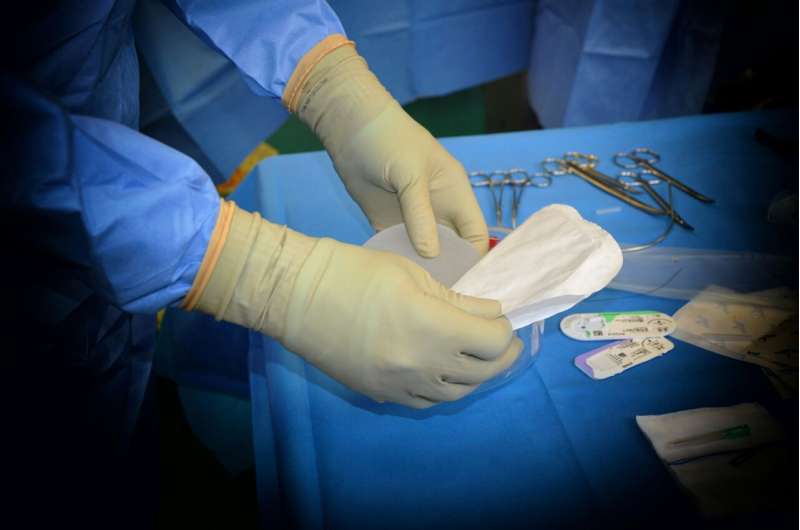This article has been reviewed according to Science X's editorial process and policies. Editors have highlighted the following attributes while ensuring the content's credibility:
fact-checked
peer-reviewed publication
trusted source
proofread
Evolving trends in cosmetic breast augmentation

Ongoing quality improvement data submitted by Board-certified plastic surgeons highlight current trends in surgical technique in cosmetic breast augmentation using implants, reports a study in the December issue of Plastic and Reconstructive Surgery, the official medical journal of the American Society of Plastic Surgeons (ASPS).
"The findings illustrate evolving trends in breast enhancement over the past 16 years, including factors like the location of the incision and the type and positioning of implants," comments lead author Michael J. Stein, MD, MAS, FRCSC, FACS of Lenox Hill Hospital, New York, N.Y. "The data reflect current best practice among Board-certified plastic surgeons, with attention to safety issues and the latest research evidence."
Trends in breast enlargement technique from 2005 to 2020
Breast augmentation is the most frequently performed cosmetic plastic surgery procedure. In 2022, ASPS Member Surgeons performed nearly 300,000 breast augmentation procedures, according to ASPS statistics. To assess practice patterns and surgical techniques over time, Dr. Stein and colleagues analyzed data from the Continuous Certification process of the American Board of Plastic Surgery (ABPS).
In that process, plastic surgeons submit information on frequently performed "tracer procedures" as evidence of ongoing improvement in clinical practice. The study included data on 31,700 breast augmentation cases submitted by 1,082 surgeons between 2005 and 2020. Cases were divided into early (2005-14) and recent (2015-20) cohorts to assess trends in surgical technique over time.
Patients in the more recent cohort were less likely to smoke, 12% versus 8%; and less likely to have preoperative mammograms, 29% versus 24%. Women in the recent cohort were more likely to have ptosis (sagging) of the breasts: 23% versus 20%.
The data showed changing practice patterns in several key areas from the early to the recent period:
- Use of inframammary incisions (under the breast fold) increased from 68% to 80%. Meanwhile, use of peri-areolar (around the nipple area) incisions decreased from 24% to 14%.
- Submuscular implant placement (under the pectoralis major muscle) increased greatly: from 22% to 56%. At the same time, the use of subglandular implant placement ("over the muscle"—under the breast gland tissue) decreased from 19% to 7%.
- Use of textured implants increased from 2% in 2011 to 16% in 2016—reflecting a belief that textured implants could reduce problems with scar tissue (contracture) around the implants. However, use of textured implants dropped precipitously starting in 2019 and has since stopped completely. Textured implants were used in 0% of cases from 2020 onwards.
'Focus on evidence-based practice to maximize patient safety and patient satisfaction'
Discontinuation of textured implants reflected FDA warnings about a rare form of cancer associated with this type of implant (breast implant-associated anaplastic large cell lymphoma, or BIA-ALCL). Other trends in surgical technique—including increased use of the inframammary incision and "under the muscle" implant placement—were consistent with new evidence-based studies.
While not without limitations, the use of ABPS Continuous Certification data provides an "excellent resource" for assessing trends in plastic surgery over time, according to the authors. Dr. Stein comments: "Our findings lend insights into the continuous evolution of surgical technique in breast augmentation by Board-certified plastic surgeons, with a focus on evidence-based practice to maximize patient safety and patient satisfaction."
Senior author Arun K. Gosain, MD, of Lurie Children's Hospital, Chicago, has initiated similar reviews using ABPS Continuous Certification data for a variety of tracer procedures, focused on craniofacial surgery, hand surgery, and aesthetic surgery. Dr. Gosain comments: "The current review highlights the value of Continuous Certification for practicing plastic surgeons, allowing them to assess their practice patterns relative to those of their colleagues and to evaluate how these practice patterns have evolved over time."
More information: Michael J. Stein et al, Practice Patterns in Primary Breast Augmentation: A 16-Year Review of Continuous Certification Tracer Data from the American Board of Plastic Surgery, Plastic & Reconstructive Surgery (2023). DOI: 10.1097/PRS.0000000000010497


















